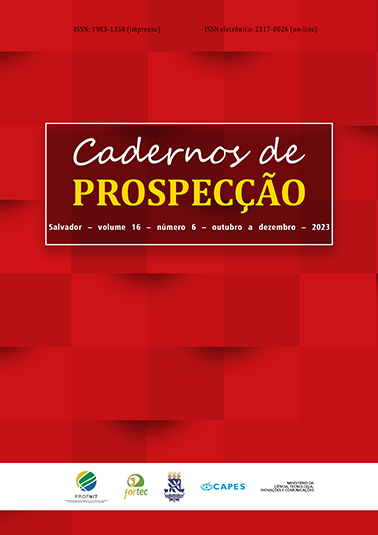Strategic Potential of Cowpea as an Ingredient for Plant-Based Foods
DOI:
https://doi.org/10.9771/cp.v16i6.52936Keywords:
Vigna unguiculata, Pulses, Vegans.Abstract
Cowpea grains have high levels of protein, fiber, iron and zinc, which gives them an excellent nutritional potential for the development of plant-based foods, generally vegan, made from plants as an option to animal products. The objective of this research was to obtain information about the cowpea culture in Brazil and in the world, as well as about the development of plant-based foods in recent years. The results indicate that most of the formulations that use pulses consist of peas, chickpeas and broad beans, but very few have used cowpea, which represents a great strategic opportunity for this crop in this type of food technology. In addition, the results show an accelerated growth trend in the development of technologies in the plant-based food sector, accompanied by strong investments by the main industries in the sector.
Downloads
References
CONAB – COMPANHIA NACIONAL DE ABASTECIMENTO. Acompanhamento da Safra Brasileira de Grãos, Brasília, DF, v. 9, safra 2021/22, n. 8, Oitavo levantamento, abril 2022a. Disponível em: https://www.conab.gov.br/component/k2/item/download/42060_b71f67c5c00a1b18b71d326ab3d576c0. Acesso em: 8 jun. 2022.
CONAB – COMPANHIA NACIONAL DE ABASTECIMENTO. ERRATA – Tabela de dados - Produção e balanço de oferta e demanda de grãos, Brasília, DF, safras 2020/21 e 2021/22, n. 8, Estimativa em maio, 2022b. Disponível em: https://www.conab.gov.br/component/k2/item/download/42059_dacda7ac44e3141124fac1a747b2f095. Acesso em: 8 jun. 2022.
ELSEVIER BV. Scopus. 2022. Disponível em: https://www.scopus.com/search/form.uri? display= basic#basic. Acesso em: 20 jun. 2022.
EMBRAPA ARROZ E FEIJÃO. Dados conjunturais da produção de feijão comum (Phaseolus vulgaris L.) e caupi (Vigna unguiculata (L.) Walp) no Brasil (1985 a 2020): área, produção e rendimento. Santo Antônio de Goiás: Embrapa Arroz e Feijão, 2021. Disponível em: http://www.cnpaf.embrapa.br/socioeconomia/index.htm. Acesso em: 17 jun. 2022.
EMBRAPA MEIO-NORTE. Relatório de avaliação dos impactos das soluções tecnológicas geradas pela Embrapa: Cultivares de feijão-caupi no estado do Mato Grosso. Teresina: Embrapa Meio-Norte, 2018.
FAO – FOOD AND AGRICULTURE ORGANIZATION OF THE UNITED NATIONS. FAOSTAT. Crops and livestock products. Cow peas, dry. 2020. Disponível em: https://www.fao.org/faostat/en/#data/QCL/visualize. Acesso em 17 jun. 2022.
FREIRE FILHO, F. R. et al. Feijão-caupi no Brasil: produção, melhoramento genético, avanços e desafios. 1. ed. Teresina: Embrapa Meio-Norte, 2011. 84p.
GFI – THE GOOD FOOD INSTITUTE BRAZIL. Indústrias de Proteínas Alternativas. 2020. Disponível em: http://gfi.org.br/wp-content/uploads/2020/06/GFI_2020_IndProtAlternativas.pdf Acesso em: 8 nov. 2022.
MACIEL NETO, P. et al. Alimentos Plant-Based: Estudo dos critérios de escolha do consumidor. Research, Society and Development, [s.l.], v. 9, n. 7, p. e984974980, 2020.
MENEZES JÚNIOR, J. A. N. et al. Feijão-Caupi Safrinha. In: CARDOSO, M. J. et al. Feijão-caupi: o produtor pergunta, a Embrapa responde. Brasília, DF: Embrapa, 2017. p. 201-212. Disponível em: https://ainfo.cnptia.embrapa.br/digital/bitstream/item/172079/1/500P500R-Feijao-caupiCap18.pdf. Acesso em: 2 fev. 2023.
METICULOUS RESEARCH. Europe Plant-based Food Market: Forecast to 2029. Pimpri-Chinchwad, India, Set. 2022. 191p. Disponível em: https://www.meticulousresearch.com/product/europe-plant-based-food-market-5260. Acesso em: 9 nov. 2022.
MAPA – MINISTÉRIO DA AGRICULTURA, PECUÁRIA E ABASTECIMENTO. Registro Nacional de Cultivares – RNC. Plataforma CultivarWeb. 2022a. Disponível em: https://sistemas.agricultura.gov.br/snpc/cultivarweb/cultivares_registradas.php. Acesso em: 8 jun. 2022.
MAPA – MINISTÉRIO DA AGRICULTURA, PECUÁRIA E ABASTECIMENTO. Serviço Nacional de Proteção de Cultivares – SNPC. Plataforma CultivarWeb. 2022b. Disponível em: https://sistemas.agricultura.gov.br/snpc/cultivarweb/cultivares_protegidas.php. Acesso em: 8 jun. 2022.
NESTLÉ. Nestlé Brasil investe mais de R$ 15 milhões em portfólio plant-based. Press Releases: Informações. 2020. Disponível em: https://www.nestle.com.br/media/pressreleases/allpressreleases/nestl%C3%A9-brasil-investe-mais-de-r-15-milh%C3%B5es-em-portf%C3%B3lio-plant-based. Acesso em: 2 ago. 2022.
OLIVEIRA, I. J. et al. BRS Tumucumaque – Cultivar de feijão-caupi com valor nutritivo para o Amazonas: Comunicado Técnico 106. Manaus: Embrapa Amazônia Ocidental, 2014. 4p. Disponível em: https://ainfo.cnptia.embrapa.br/digital/bitstream/item/109209/ 1/Com-Tec-106-2.pdf. Acesso em: 22 jun. 2022.
ORBIT INTELLIGENCE BY QUESTEL. Orbit. 2022. Disponível em: www.orbit.com/. Acesso em: 21 jun. 2022.
QUINTELLA, C. M. et al. Maturidade Tecnológica: Níveis de Prontidão TRL. In: RIBEIRO, N. M. (org.). PROFNIT, Prospecção Tecnológica. 1. ed. Salvador, BA: Editora do IFBA, 2019. v. 2, p. 18-59.
ROCHA, M. M.; DAMASCENO-SILVA, K. J.; MENEZES-JUNIOR, J. A. Cultivares. In: DOVALE, J. C.; BERTINI, C.; BORÉM, A. (ed.). Feijão-caupi do Plantio à Colheita. Viçosa, MG: Ed. UFV, 2017. p. 113-142.
SALES, M. G.; RODRIGUES, M. A. C. Consumo, qualidade nutricional e métodos de preparo do caupi. In: ARAÚJO, J. P. P.; WATT, E. E. (org). O caupi no Brasil. Brasília, DF: Embrapa, 1988. p. 697-722.
SILVA, K. J. D. et al. Socioeconomia. In: BASTOS, E. A. (org.). A Cultura do Feijão-caupi no Brasil. Teresina: Embrapa Meio-Norte, 2016. p. 6-12.
STUCCHI, A. Consumo de alimentos plant-based no Brasil cresceu 70% em 5 anos. Vegan Business, São Paulo, 25 de nov. de 2020. Disponível em: https:/veganbusiness.com.br/consumo-de-alimentos-plant-based/ Acesso em: 9 nov. 2022.
WANKENNE, M. A. Avaliação cartesiana da evolução do mercado Plant-Based. Revista PLANT-BASED BR, São Paulo, 1. ed. p. 4-5, 2022. Disponível em: https://plantbasedfoods.com.br/revistas/pb-ed01/#p=4. Acesso em: 4 ago. 2022.
Downloads
Published
How to Cite
Issue
Section
License
Copyright (c) 2023 Cadernos de Prospecção

This work is licensed under a Creative Commons Attribution-NonCommercial 4.0 International License.
O autor declara que: - Todos os autores foram nomeados. - Está submetendo o manuscrito com o consentimento dos outros autores. - Caso o trabalho submetido tiver sido contratado por algum empregador, tem o consentimento do referido empregador. - Os autores estão cientes de que é condição de publicação que os manuscritos submetidos a esta revista não tenham sido publicados anteriormente e não sejam submetidos ou publicados simultaneamente em outro periódico sem prévia autorização do Conselho Editorial. - Os autores concordam que o seu artigo ou parte dele possa ser distribuído e/ou reproduzido por qualquer forma, incluindo traduções, desde que sejam citados de modo completo esta revista e os autores do manuscrito. - Revista Cadernos de Prospecção está licenciado com uma Licença Creative Commons Attribution 4.0. Esta licença permite que outros remixem, adaptem e criem a partir do seu trabalho para fins não comerciais, e embora os novos trabalhos tenham de lhe atribuir o devido crédito e não possam ser usados para fins comerciais, os usuários não têm de licenciar esses trabalhos derivados sob os mesmos termos.
Este obra está licenciado com uma Licença Creative Commons Atribuição 4.0 Internacional.





